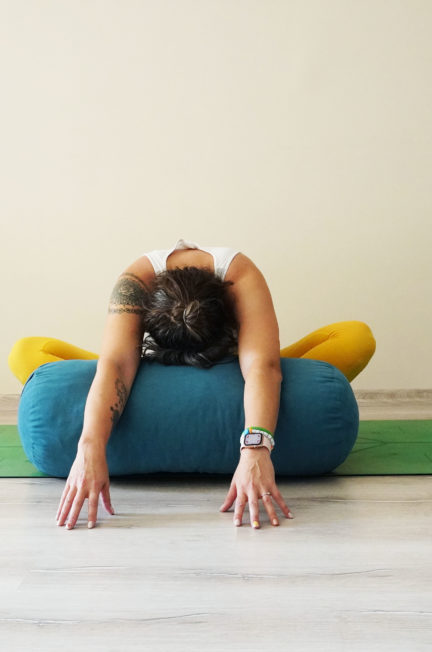Interested in beginning a yoga routine or starting up again after taking a break? We’ve got five top tips for you to settle into a practice that works for your mind, body, and budget.

1. Work with what you’ve got
You don’t need to buy a brand new wardrobe or the hottest new yoga tights on the market to hit the mat. Comfy clothing that allows you flexibility is key. Wide hems will slide up the leg. An oversized tee will slide down during Downward Dog. To settle into an asana, or yoga pose, a pair of lightweight boho harem pants paired with a broken-in tank from your closet could be all that you need on the mat.
Speaking of mats, many of us have a Pilates or exercise mat gathering dust in a corner next to a discarded kettlebell and dented tennis racket. Before you rush out and buy a recycled rubber or hemp yoga mat to keep up with the OM vibe of your local yoga studio, consider the following.
Ideally, a yoga mat will:
- Offer support (on average, most mats are 4mm-6mm or ⅛”-¼” thick) and an anti-slip surface
- Be easy to clean with a spritz of white vinegar mixed with lavender oil (my favorite)
- Be long enough for your height, so double check before you buy and read reviews online
- Feel good when you stretch out in Savasana, or Corpse Pose
- Be within your budget
Buying a top of the line mat doesn’t ensure the perfect headstand. You may even prefer to dust off that Pilates mat and see if it supports your knees and wrists, as long as it provides you with enough traction. Just remember, yoga mats have evolved over time from basic cloths, rugs, sticky mats, toxic PVC mats and towels to what we now think of as the modern-day yoga mat. So start where you are. Even if all you have is a carpet, it will do at home if it means the difference between adopting a pose or skipping a practice.
2. When you’re beginning a yoga routine, ease into it
Make realistic goals. Many people get fired up about how good they feel after a yoga class. While they clear their schedule to attend daily sessions, they hit burnout or get injured. Yoga is not a competition, no matter how it might seem in your morning class where everyone seems bendy except for you.
Instead of rushing full steam ahead, slow down and yourself: how can I best respect my body and schedule?
For many people, one or two days a week works well. One hour a week is a stretch for some, but 90 minutes is a breeze for others. Explore and discover what works for you. Build up a yoga practice over time, with a commitment to healthy habits at the forefront, so you can maintain not only your progress but peace of mind.
3. Aim for progress, not perfection
Yoga practice is just that — a practice that is done over time. As a result, every day will feel different, depending on sleep, hydration, stress, nutrition, inflammation in the body, and age. In addition, allow time for hamstrings to relax, for muscles to warm up, and for joints to adapt to weight-bearing poses. Try not to expect to perform a Sirsasana, or headstand, on the first try.
Gauge your progress based on internal clues and not external ones, and you’ll leave your practice with your body humming instead of mind spinning.
4. Respect your body
It’s not about whether you can perform Crow Pose, or Bakasana in Sanskrit, with both feet off the ground versus lifting one foot at a time. It’s about feeling good in a pose. Adapt to your body’s needs, including your menstrual cycle.

Experiment with testing your limits, but not at the expense of your hips, shoulders, and knees. Consider introducing a Yin Yoga routine to support joint health.
5. Beginning a yoga routine? Be curious
Ask yourself in a pose: how does this feel? Align your breath with your movements. Take time to check your positioning and transition with as much ease as possible. Get curious about the signals your body is sending you. Some poses are more challenging than others, but you may surprise yourself when a difficult one comes easily. The bottom line is that each body is individual, and every practice is different.
Get curious about the sensations in your body. Allowing time before each session to do breathing exercises and time after to relax will create more ease in your movements and throughout your daily life.

Rose Margaret Deniz is an artist, writer, and yoga instructor @roselayoga. The farm-girl turned expat has been gluten-free for over 12 years, and can be found in her kitchen whipping up seasonal meals for her bilingual family, growing herbs in her garden, painting and writing in her studio, and practicing yoga.






